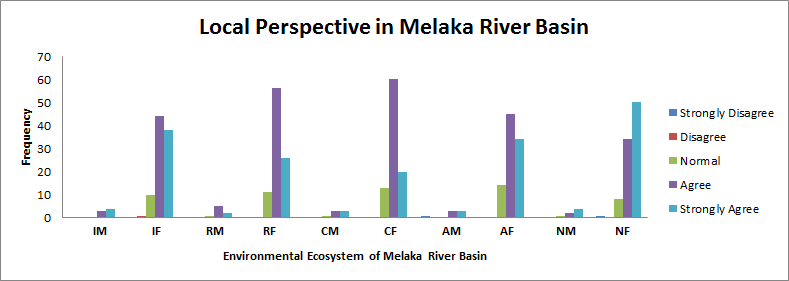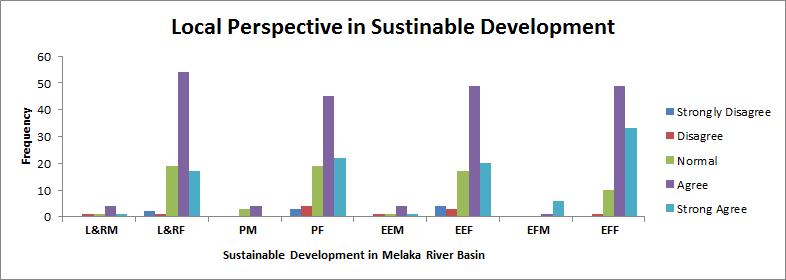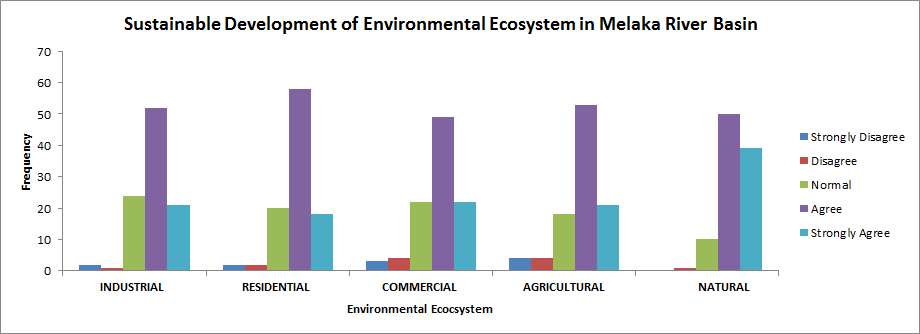Abstract
Different form of development planning and management approaches have been applied and implemented by many countries in river basins for the past decades. Nevertheless, the outcomes are disappointing. This study aims to explore the local people awareness towards environmental ecosystem by adopting sustainable development. A quantitative method through the questionnaire was reported in two parts. Part A was the environmental ecosystem study while Part B was the sustainable development study. Random sampling technique with 100 respondents was targeted within Melaka River basin. Descriptive analysis showed majority of the respondents were positively agreed that industrial, residential, commercial and agricultural activities would contribute water contamination to the Melaka River basin. Meanwhile, sustainable development of law and regulation, policy, environmental ethics, as well as environmentally friendly were likely to have skewed graph shift towards right hand side, whereby respondents believed that these sustainable development had a possibility to control and manage the river pollution in Melaka River basin. Correlation analysis showed sustainable development positively impacts on the environmental ecosystem in Melaka River basin. In conclusion, implementing and adapting the sustainable development approach would indirectly preserve and conserve the environmental ecosystem before anthropogenic activities take place to destruct the water quality in Melaka River basin.
Keywords: Development planning and managementenvironmental ecosystemsustainable developmentpreserveconserve
Introduction
According to Environmental Department of National Geographic, most of the developing countries dumped untreated industry waste into the river up to 70% without any preliminary treatment which contaminates the water resources of residents (National Geographic Official Portal, 2019). Approximately 45 million kilograms of fertiliser (or 99 million pounds) as well as the chemicals are used in every year for agriculture activities. About 1.8 billion kilograms of human waste (or 2 million tons) are dumped into surface water daily. The most contaminated rivers in the world are Ganges River and Yamuna River from India, Jian River from China, Jakarta River from Indonesia, Pasig River from the Philippines, as well as Tiete River from Brazil (Bittner, 2013). The contamination occurred due to the chemical waste dumping from industrial, rubbish and failure function of the sewage treatment system. In Malaysia, about 46% of rivers were found to be clean while 43% are slightly to be polluted and 11% of rivers are in polluted condition (Department of Environment Malaysia, 2017). Compared to the previous statistic in 2012, 59% of rivers are considered clean, 34% are moderately (or slightly) polluted and 7% are polluted rivers. Thus, most of the rivers are shifted from the clean condition into slightly polluted and polluted condition due to industrial activities along the river. These rivers were including Sungai Rajang, Sungai Selangor, Sungai Sarawak and Sungai Melaka (DOE, 2017). Since Melaka had been recognised as a historical tourism destination by UNESCO on July 07, 2008 (UNESCO Official Portal, 2015), it indirectly has attracted the increasing of the population by migrating from another state of Malaysia to Melaka. Drastic increased of people especially in the Melaka Central is due to employability opportunities and bring various benefits to the local citizen.
Problem Statement
Several researchers had reported that river water quality was polluted because of the degradable organics and nutrients released from domestic effluents, and agricultural wastes. Also, surface and subsurface water runoff in urban activities, industrial activities, as well as farming field activities contribute the most to the water river quality (Hua, 2017a; Hua et al., 2016; Mishra et al., 2016; Rezaei & Sayadi, 2015). Similarly, inadvertent development along Melaka River has caused serious environmental issues and problems due to contamination of water resources (Nasbah, 2010). Other than that, anthropogenic activities such as bathing, washing and others also contribute a lot to the pollution in Melaka River (Hua, 2019; 2017b; Nasbah, 2010). According to Hua (2019), there were various human activities were carried out along Melaka river from the upstream which was identified significantly correlated with agricultural and livestock activities (Hua, 2017a; 2017b). Meanwhile, the middle stream of the river was influenced by the factories and settlement activities, and downstream river because of the commercial activities (Hua, 2017a, 2017b; Hua et al, 2016; Daneshmand et al., 2011).
Research Questions
This study attempted to explore the local people awareness towards environmental ecosystem by adopting sustainable development in Melaka River basin. Therefore, the basic research questions were as follows;
What is the extent of river pollution occurrence in the Melaka River?
Do local people aware the circumstances of river water quality level in Melaka River basin?
Do the local people adapt sustainable development approach in Melaka River basin?
Purpose of the Study
Sustainable development had been introduced, designed and implemented by Malaysia government into the daily life of the citizen. Due to continuous depletion of water quality in Melaka River basin, therefore, it is essential to protect the water resources by determine the possibility for implementation of sustainable development in the environment. Hence, this research study aims to explore the local people awareness towards environmental ecosystem by adopting sustainable development in Melaka River basin.
Research Methods
The questionnaires were set and designed into two parts, namely part A is the environmental ecosystem study, and part B is the sustainable development study. Both parts of questionnaire used Likert Scale method, which consists of five (5) points; strongly disagree, disagree, normal, agree, and strongly agree. This research study targeted 100 respondents. The selection of respondents was based on
Findings
The descriptive analysis with a total of 100 respondents indicates majority are strongly agreed and agreed that the river water quality in Melaka River is contaminated due to the activities of industrial, residential, commercial, agricultural, and natural consequences (Table

Meanwhile, local perspective towards the sustainable development program includes law and regulation, policy, environmental ethics, and environmentally friendly are determined to have skewed graph shift towards right-hand side (Table

Next, the correlation analysis in Table

Conclusion
In summary, local residents are positively agreed that residential, industrial and agricultural activities play an important role in anthropogenic activities to affect the river water quality, while significantly highlight that law and regulation, environmental ethics, environmentally friendly, as well as policy, are considered the most significant sustainable development program in protecting the water in Melaka River. Moreover, significant relation between environmental ecosystems into sustainable development is expected to protect, conserve and preserve the environmental nature through short-and-long term planning from being continuously destructed by the anthropogenic activities. Thus, this study indicates limited number of man power in receiving questionnaire survey would be the main challenges in determination for sustainable development of environmental ecosystem in Melaka River Basin.
References
- Bittner, M. (2013). The World’s Most Polluted River. EHS Journal. http:/ehsjournal.org/michael-bittner/the-worlds-most-polluted-rivers/2013/
- Daneshmand, S., Huat, B. B., Moayedi, H., & Ali, T. A. M. (2011). Study on water quality parameters of linggi and melaka rivers catchments in Malaysia. Engineering Journal, 15(4), 41-52. https://doi.org/10.4186/ej.2011.15.4.41
- Department of Environment (DOE) (2017). Malaysia Environmental Quality Report2017.
- Hua, A. K. (2019). Applied structural equation model in sustainable development of water resources management. Journal of Water and Land Development, 42(1), 83-90.
- Hua, A. K. (2017a). Analytical and detection sources of pollution based environmetric techniques in Malacca River, Malaysia. Applied Ecology and Environmental Research, 15(1), 485-499. https://doi.org/10.15666/aeer/1501_485499
- Hua, A. K. (2017b). Land use land cover changes in detection of water quality: a study based on remote sensing and multivariate statistics. Journal of environmental and public health. https://doi.org/10.1155/2017/7515130
- Hua, A. K., Kusin, F. M., & Praveena, S. M. (2016). Spatial Variation Assessment of River Water Quality Using Environmetric Techniques. Polish Journal of Environmental Studies, 25(6), 2411–2421. https://doi.org/10.15244/pjoes/64082
- Mishra, S., Kumar, A., & Shukla, P. (2016). Study of water quality in Hindon River using pollution index and environmetrics, India. Desalination and Water Treatment, 57(41), 19121-19130.
- Nasbah, N. N. (2010). Sungai Melaka Tercemar. Utusan Online. http://ww1.utusan.com.my/utusan/info.asp?y=2010&dt=0123&sec=Selatan&pg=ws_01.htm
- Nunez, C. (2010, March 16). Fresh Water: Pollution. https://www.nationalgeographic.com/environment/ freshwater/pollution/
- Rezaei, A., & Sayadi, M. H. (2015). Long-term evolution of the composition of surface water from the River Gharasoo, Iran: a case study using multivariate statistical techniques. Environmental geochemistry and health, 37(2), 251-261.
- UNESCO Official Portal (2015). Melaka and George Town, Historic Cities of the Straits of Malacca. https://whc.unesco.org/en/list/1223/
Copyright information

This work is licensed under a Creative Commons Attribution-NonCommercial-NoDerivatives 4.0 International License.
About this article
Publication Date
12 October 2020
Article Doi
eBook ISBN
978-1-80296-088-4
Publisher
European Publisher
Volume
89
Print ISBN (optional)
-
Edition Number
1st Edition
Pages
1-796
Subjects
Business, innovation, sustainability, environment, green business, environmental issues, urban planning, municipal planning, disasters, social impact of disasters
Cite this article as:
Hua, A. K., Gani, P., Yusof, J., Abdul Halim, N. H., & Yahya, S. B. (2020). Implementation of Sustainable Development Towards Environmental Ecosystem in Melaka River Basin. In N. Samat, J. Sulong, M. Pourya Asl, P. Keikhosrokiani, Y. Azam, & S. T. K. Leng (Eds.), Innovation and Transformation in Humanities for a Sustainable Tomorrow, vol 89. European Proceedings of Social and Behavioural Sciences (pp. 172-178). European Publisher. https://doi.org/10.15405/epsbs.2020.10.02.16

